
According to a new study published three days ago in JAMA the U.S. Preventive Services Task Force (USPSTF) recommended the use of statins for primary prevention of cardiovascular disease. They advocate the use of low- to moderate-dose statins in adults ages 40 to 75 years without a history of cardiovascular disease (CVD) who have one or more CVD risk factors (dyslipidemia diabetes hypertension or smoking) and a calculated 10-year CVD event risk of 10% or greater.1 The USPSTF concluded that the harm of low- to moderate-dose statin use in these adults is minimal.
In contrast recent studies demonstrated how the education on statins is deceptive and creates the appearance that they are safe and effective in the prevention of CVD. There is no question that statins are effective at reducing cholesterol levels but they have failed to substantially improve cardiovascular outcomes or reduce the risk of mortality.2 The role of high cholesterol as an etiological factor in CVD has been a source of controversy and debate for decades. Studies have demonstrated that older adults with low levels of cholesterol are just as atherosclerotic as those with high levels.3
Also another study demonstrated how statins stimulate atherosclerosis and heart failure. This study suggests that statins may be causative in coronary artery calcification and can act as mitochondrial toxins that impair muscle function in the heart and blood vessels through the depletion of CoQ10 and ATP generation.4
Statins inhibit the synthesis of vitamin K2 a vitamin necessary to protect the arteries from calcification. In addition statins inhibit the biosynthesis of selenium-containing proteins. This impairment may be a factor in congestive heart failure as a selenium deficiency is seen with cardiomyopathies.
Health care providers have many more tools today than simply looking at the standard lipid panel to assess cardiovascular health. It is essential to perform a thorough assessment for all of these patients by looking at lipid fractionation profiles chronic inflammatory markers (ferritin hs-CRP fibrinogen) nutrient markers (magnesium potassium selenium copper folate B12 B6 zinc and calcium) fat soluble vitamins (A D & K and CoQ10) oxidative stress factors (homocysteine insulin and lipid peroxidases) heavy metals and a fatty acid profile.
At the end of the day protocol-driven treatment like this fails. Each person's biochemical individuality exerts a major influence on his or her health. The level of nutrient intake that maintains the best possible health is highly variable from person to person. Lifestyle choices and environmental exposures filtered through genetic predisposition are fundamental factors in the expression of disease and a successful treatment approach must include investigation into these factors.
By Michael Jurgelewicz DC DACBN DCBCN CNS